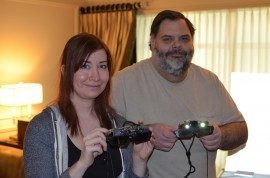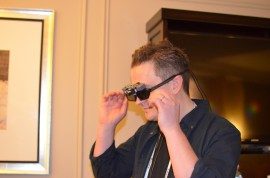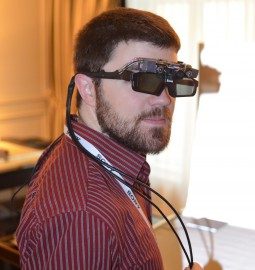Road to VR’s Paul James sits down to talk with the founders of Technical Illusions, Jeri Ellsworth and Rick Johnson and we get our hands on the new HD Prototype.
Genuine
Jeri and Rick don’t really want to be doing yet another interview. They’re people who love their work, who’d really much rather be back in their labs, making great tech than speaking to journalists. And who can blame them? After months on the road, dozens of public events and countless showings of their exciting new technology I think I’d want a bit of peace too.
Despite this however, they remain warm, welcoming and still infectiously enthusiastic about CastAR, their augmented reality gaming

system which brings 3D holographic-effect imagery to the consumer market and handily carves its own niche in the home entertainment market at the same time.
Their pretention free, genuine nature was a large part of their Kickstarter success in this writer’s opinion – proving that even in the age of expensive Kickstarter videos with flashy visuals, people appreciate a bit of straight talking over everything else.
Table-Top Gaming is Dead, Long Live CastAR
Of course, the other reason why their Kickstarter raised a little over $1M in under 30 days was that CastAR is an incredibly cool invention. Not only does it place 3D imagery in your real world, it manages to simultaneously allow and encourage collaborative, competitive social interaction. The beauty of CastAR is that every player has their own projected image, seen only by them. In multiplayer games, where players share a single space, it means you get your own view of the playspace. If not, everyone see’s their own custom view but remain physically sat in the same space. It’s the kind of technology that encourages being with other human beings and more than that, threatens to hail the end of that family stalwart the board game. There’d be very little need for parents to emotionally blackmail their kids into ‘family time’ if the kitchen table was alive with 3D animated characters scenery.

In augmented reality mode, CastAR is the antithesis of the solitary, isolated experience offered by the likes of the Oculus Rift. And in many ways there are parallels here with the previous generation of consoles. Specifically the kind of hardcore experience catered by the Xbox gamepad versus the more social, collaborative, at times progressive and above all intuitive gameplay the Nintendo Wii encouraged (when it wasn’t peddling dreadful shovel ware). CastAR offers that sort of potential, to attract a previously undiscovered segment of the world who’d never bothered to try gaming before.
CastAR Goes HD
Those who have been lucky enough to glimpse early versions of the CastAR glasses at the various conventions and fairs around the US will likely have seen the original working prototypes. These units used dual standard definition, 120Hz LED projectors, capable of a bright, stable image albeit lacking the sharpness we usually demand in today’s display technology. The goal however was always to target dual HD, 720p projectors to sharpen that image up.
Road to VR were lucky enough to have the first hands-on session with the new HD Prototype and were able to compare and contrast wit the SD units. The results of that uplift in resolution is pretty much immediately evident, viewing now classic CastAR ‘3D Chess board over volcano’ demo – resolvable detail was much improved as was the 3D depth effect, with better defined edged to sell the effect with.

Brightness was more difficult to judge with such limited time and in a room flooded with natural and ambient light. The conditions do prove however that CastAR is eminently usable in naturally lit environments, an impressive feat given the size of the projectors. Contrast ratio is however obviously only as good as the darkest shade on you projection surface, which means CastAR will never excel at deep blacks. Still, I’d love to get the units into a darkened room to really soak in these holographic images in optimal projection conditions.
The HD prototype glasses I wore got noticeably warm during use. Expecting this to be down to the projectors themselves I asked Jeri whether this would feature in the final versions, she explains with a smile that the heat is being generated by an image controller that’s now somewhat overworked with the new, higher resolution. The projector themselves when probed were comparatively cool.
The prototypes still look like the glasses equivalent of Dr Emit Brown’s DeLorean from Back to the Future, all exposed wires and boards retrofitted to the shutter glasses. This is of course because each set is still hand made by Jeri herself, a process she is continually refining. Finding more efficient board layouts and squeezing the circuitry into less and less space as time goes by.
The glasses are light and unobtrusive in use and can be worn with other glasses (as I did), and being able to see your physical surroundings certainly makes staying ‘in’ the game a much more manageable prospect when compared to the complete isolation of the Oculus Rift.
IR Tracking
With all the hype that engulfed the VR community once Oculus VR revealed their Crystal Cove prototype the day before our CastAR demo, it’s easy to forget that Technical Illusions have had their own, sub-millimetre positional head-tracking solution in place from the beginning. A deceptively simple system, the player places one or more IR tracking squares somewhere around the playing area, the

The VR ClipOnscamera mounted centrally on the glasses tracks those LEDs and uses the information to feed back head position and orientation in relation to that tracking square.
I can tell you that it works incredibly well. Rolling and moving my head in, out and around the projected scene resulted in responsive shifting of the scene to reflect my position relative to it. The effect is quite uncanny, leaning over the desk looking down through the surface to the projected virtual hole and beyond brought a smile to my face more than once. And as mentioned in our previous article, trying to outfox the tracker by slowly ducking below visibility of the LED resulted in impressively stable and tracked position right until those LEDs were completely out of sight. It’s an elegant and effective system then and I’m very much looking forward to putting it through its paces in more detail soon.
 Unfortunately the VR clip-on accessory, an addition that transforms the standard CastAR augmented reality glasses into a fully-fledged virtual reality solution, was not yet ready for prime time. Jeri assured us that progress was rapid and that they’re now targeting a rough horizontal FOV of around 90 degrees – an impressive figure that puts it toe to tow with the Rift. The clip on designs aren’t finalised, but they work by bouncing and reflecting light from the dual projectors back into each eye. The claim is that the resultant image should be much less affect by distortion and therefore require far less pre-warping before displaying gaming imagery. With a discrete 720p image for each eye, these have the potential to produce some impressively immersive images.
Unfortunately the VR clip-on accessory, an addition that transforms the standard CastAR augmented reality glasses into a fully-fledged virtual reality solution, was not yet ready for prime time. Jeri assured us that progress was rapid and that they’re now targeting a rough horizontal FOV of around 90 degrees – an impressive figure that puts it toe to tow with the Rift. The clip on designs aren’t finalised, but they work by bouncing and reflecting light from the dual projectors back into each eye. The claim is that the resultant image should be much less affect by distortion and therefore require far less pre-warping before displaying gaming imagery. With a discrete 720p image for each eye, these have the potential to produce some impressively immersive images.
It was a pleasure meeting with Jeri and Rick and to finally get our hands on this intriguing tech. There’s no doubting the system’s huge potential, especially for cracking that family and social aspect of gaming so rarely captured by traditional gaming devices. But, the VR Clipons and sub-millimetre positional head tracking offered means that Technical Illusions are also equipping CastAR to go head to head with hardcore gaming solutions.
The first sets of early access backer rewards are due to ship out to their lucky owners in April and May 2014 with the rest of the backers receiving their toys sometime in September. We’re assured that these are on track for delivery as planned.







